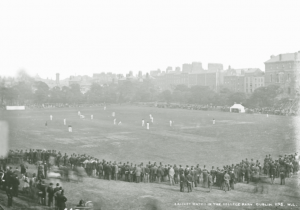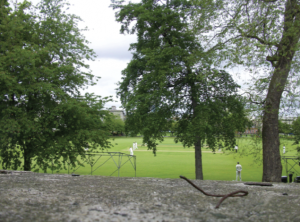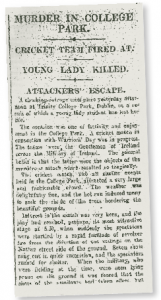‘Gentlemen of Ireland versus the Military of Ireland’, 3 June 1921
Published in 18th–19th - Century History, Features, Issue 5 (September/October 2013), Volume 21
Above: A cricket match at College Park, Trinity College, Dublin, c. 1900. The marquee to the right is roughly where Miss Kathleen Wright was shot on 3 June 1921. (NLI)
As the Gentlemen of Ireland had played only eight matches between 1910 and 1921, the War of Independence presented a golden opportunity to play decent opposition, with so many cricketing troops stationed here. A two-day match was arranged for the first weekend in June 1921 and, as always, College Park was the venue. A good crowd was guaranteed, as one of the greatest of all Irish cricketers, Bob Lambert, was taking part [see sidebar]. Lambert had his own legion of adoring fans and both as a batsman and a bowler always entertained the crowd.
The two-day match was fixed to begin at 11am on Friday 3 June to celebrate Warrior’s Day and, like every other day that summer, the sun shone. A side had to lose all its batsmen twice to lose the match. For security, the ground was ringed by troops in full battle dress. The military won the toss and decided to bat. They were soon in trouble, and after they lost their two top-class players for only nine runs they struggled to a total of 108. The equally famous Irish bowler Wenty Allen had taken five scalps in a row. Lambert and John Crawford had added 127 runs to Ireland’s score, bringing their total to 266 runs in response, and they were well on their way to a very easy win by tea at 5pm. The Irish would have a whole day on 4 June to bowl the Army out and famously win the match. If the Army survived, the match would be a draw. There was a good crowd in the morning but the park really filled up in the afternoon, as government staff (many of whom were English) finished work early on the Friday to watch it. The crowd were in good spirits as Lambert and Crawford smashed the English bowlers to all parts of the ground. The Army had underestimated the challenge presented by the Irish, and the local fans were enjoying beating the British at their own game.
Shots rang out
At 5.30pm, just as the military band was leaving the field after the tea break, shots rang out from the railings on the Nassau Street side of the ground. The band and the Army players, who were fielding, threw themselves to the ground. Not knowing what was going on, the two batsmen looked on in stunned disbelief before they too were hauled to the ground by the soldiers. According to the Irish Times, two men had cycled up
‘. . . and carefully placed their machines against the kerbstone. They advanced towards the railings and, producing revolvers, fired them in the direction of the players. They then put their revolvers in their pockets, remounted their bicycles, and rode away.’
The incident was over so quickly that most of the crowd had not even reacted before the players started to pick themselves up and check whether everyone was unhurt. The umpires and captains decided to carry on. On the face of it, even if none of the military were killed, the IRA had pulled off a ‘spectacular’.
Miss Kathleen Wright
Before another ball was bowled, the game was interrupted by another disturbance from the Nassau Street side of the ground. One of the spectators had collapsed. Miss Kathleen Wright, a Trinity student, had gone to the game with her fiancé, George Hubert Ardill, son of a clergyman in Sligo. The Irish Times reported that ‘Miss Kathleen Alexanderson Wright received a bullet wound in the back, and there was a corresponding exit wound in the breast, from which blood flowed freely’. The official Dublin Castle report in the Irish Times reported her last words as ‘I have such a pain in my chest’ before she collapsed and died. Another lady spectator sitting next to her had been shot in the arm, possibly by the same bullet. George Ardill told her inquest that three doctors had attended her and ‘one had told him there was no hope. He [George] had accompanied her to hospital where he was told she was dead’.
Another witness identified where she was sitting in the park [opposite the Kildare Street Club]:
‘He went out immediately, and ran to where a crowd was collecting inside the park railings opposite the Kildare Street Club. A few of his friends told him what had happened and said that the shots came through the railings.’
Incredibly, after the shooting the cricket match resumed. The provost of Trinity, John Henry Bernard, came to the ground, however, and the match was then abandoned. The official report ended with the comment that ‘The attackers made good their escape’.
Account in the Bureau of Military History
There matters rested until the release of the Bureau of Military History (BMH) statements in 2003. While it had been known since 2000 that Paddy O’Connor and Jim McGuiness had done the shooting, no details from the IRA side had been found. With the release of the BMH documents Paddy O’Connor’s version of events was now in the public domain:
‘During the summer of 1921 a cricket match was held in Trinity College between the Gentlemen of Ireland and the Military. We were instructed to stop this match taking place. Our instructions were that we were to go down to the vicinity of Trinity College and fire into the grounds. Jimmy McGuinness and myself cycled down as the match was just starting. From a position behind the boundary wall of Trinity College at Lincoln Place, the two of us opened fire in the general direction of the players. After the first couple of rounds were fired, a lady spectator jumped up from one of the seats and got killed by a stray shot. The match was not proceeded with.’
That, it seems, was that.
Struck at the heart of the loyalist community
The newspapers suggested that Kathleen Wright was English, but her father, Revd Ernest Alexanderson Wright, was from Ireland and was the vicar of All Saints in Clapham Park, London. His brothers included Eric Wright, supreme justice of the Seychelles, General Henry Wright, who fought in the Boer War and the Great War, Sir Almroth Wright, who created the typhoid inoculation, and Sir Charles Wright, assistant librarian at the National Library of Ireland. Her grand-uncle had been a professor of botany in Trinity. The Wright family had come to Ireland with Cromwell and had remained at the top of Irish legal, academic and military society for generations. She was one of the fourth generation to have been educated at Trinity. Kathleen Wright’s death struck right at the heart of the loyal, unionist and mostly Protestant community at play. While the military had been the target, the recklessness of firing across the spectators smacks of Bloody Sunday and the Crown forces’ attack on Croke Park in November 1920. George accompanied her body to London; after a funeral service conducted by Canon Ardill, she was buried in Wandsworth cemetery on 8 June. She was 21. HI
Barry Keane is a history and geography teacher in Cork. He is also manager of the Irish Universities cricket team.
Read More: Bob Lambert
Colonel Padraig O’Connor
Further reading
D. O’Connor & F. Connolly, Sleep, soldier, sleep. The life and times of Padraig O’Connor (Newbridge, 2011).
G. Siggins & J. Fitzgerald, Ireland’s 100 cricket greats (Dublin, 2006).
T. West, The bold collegians. The development of sport in Trinity College (Dublin, 1991).


















